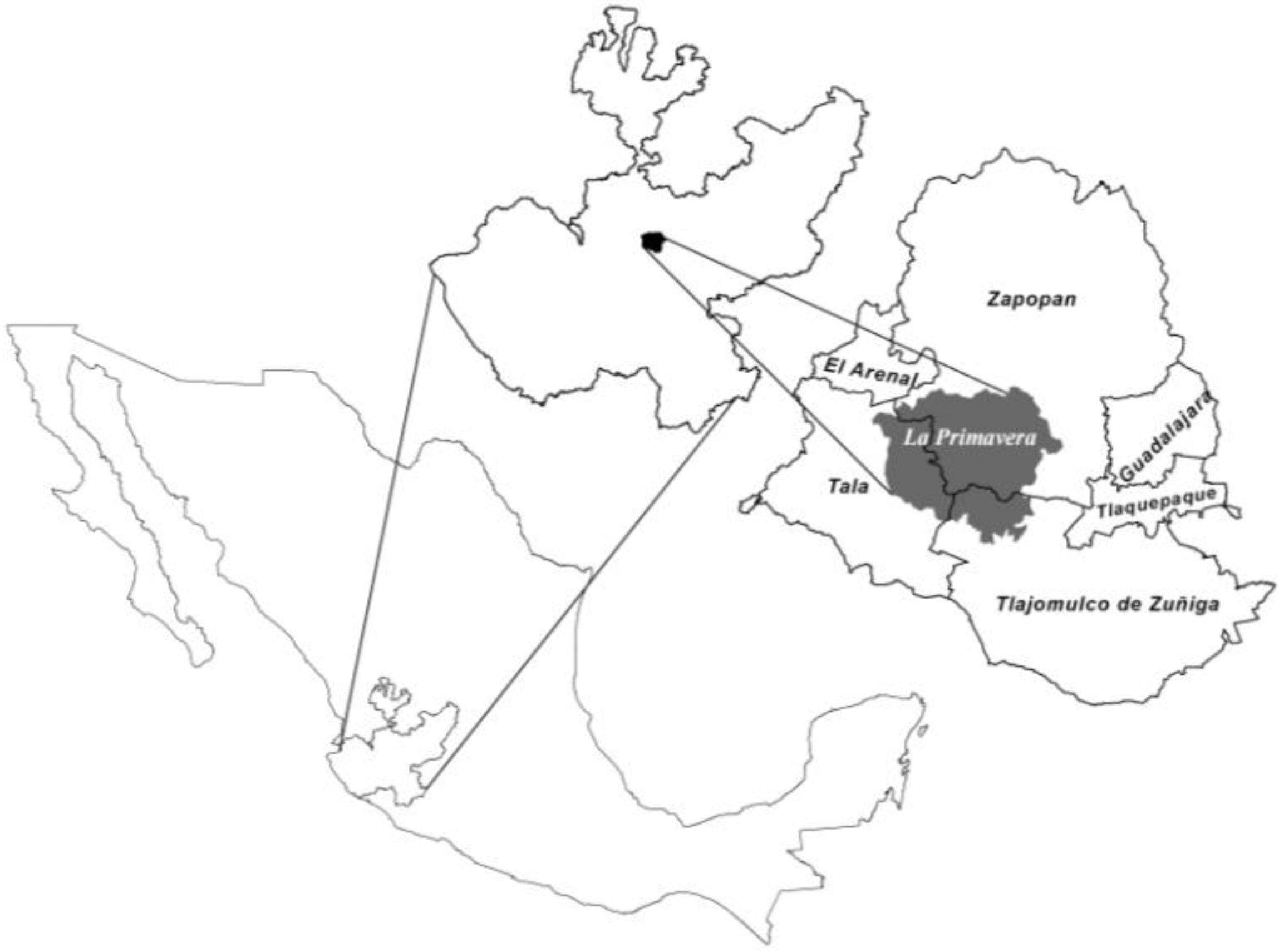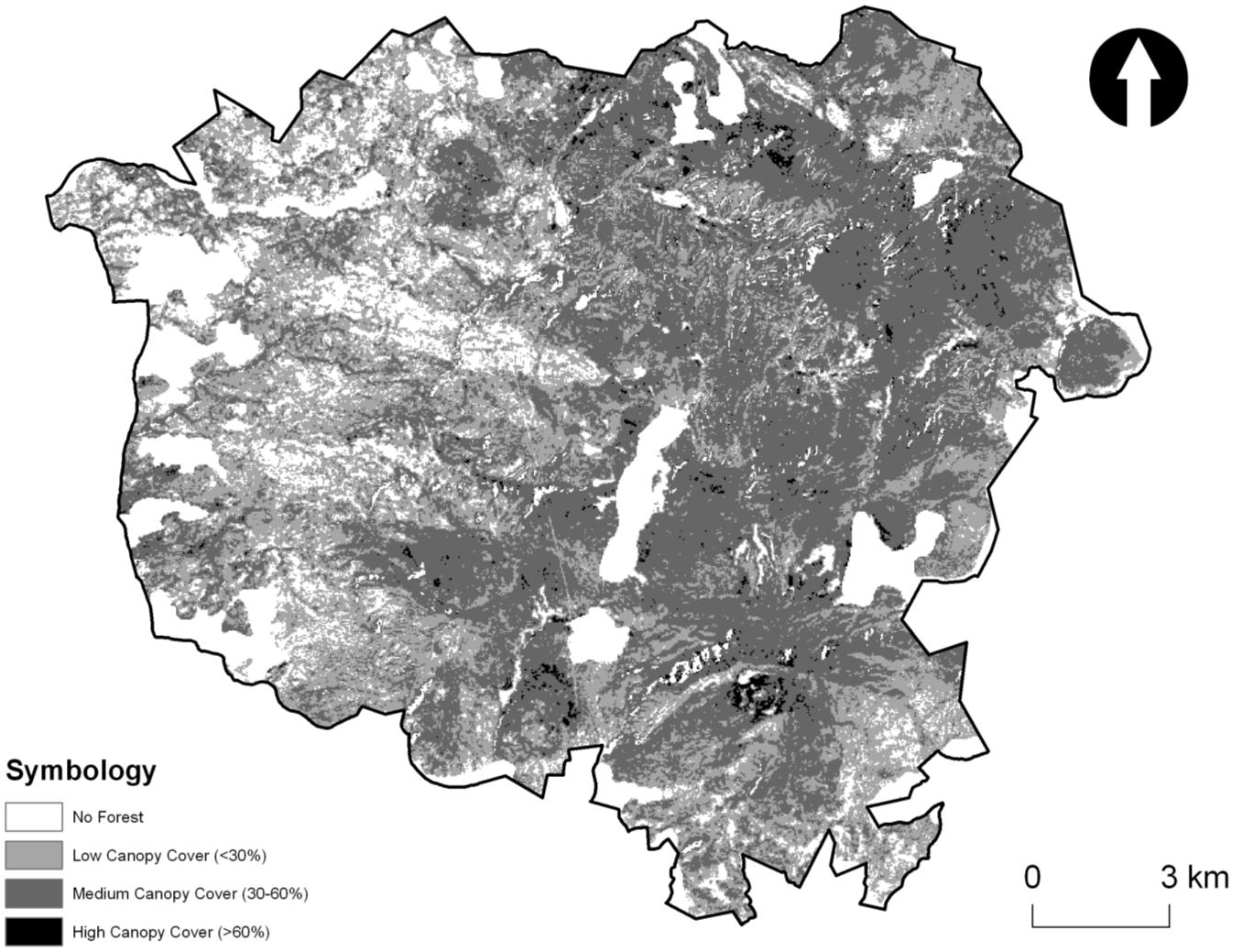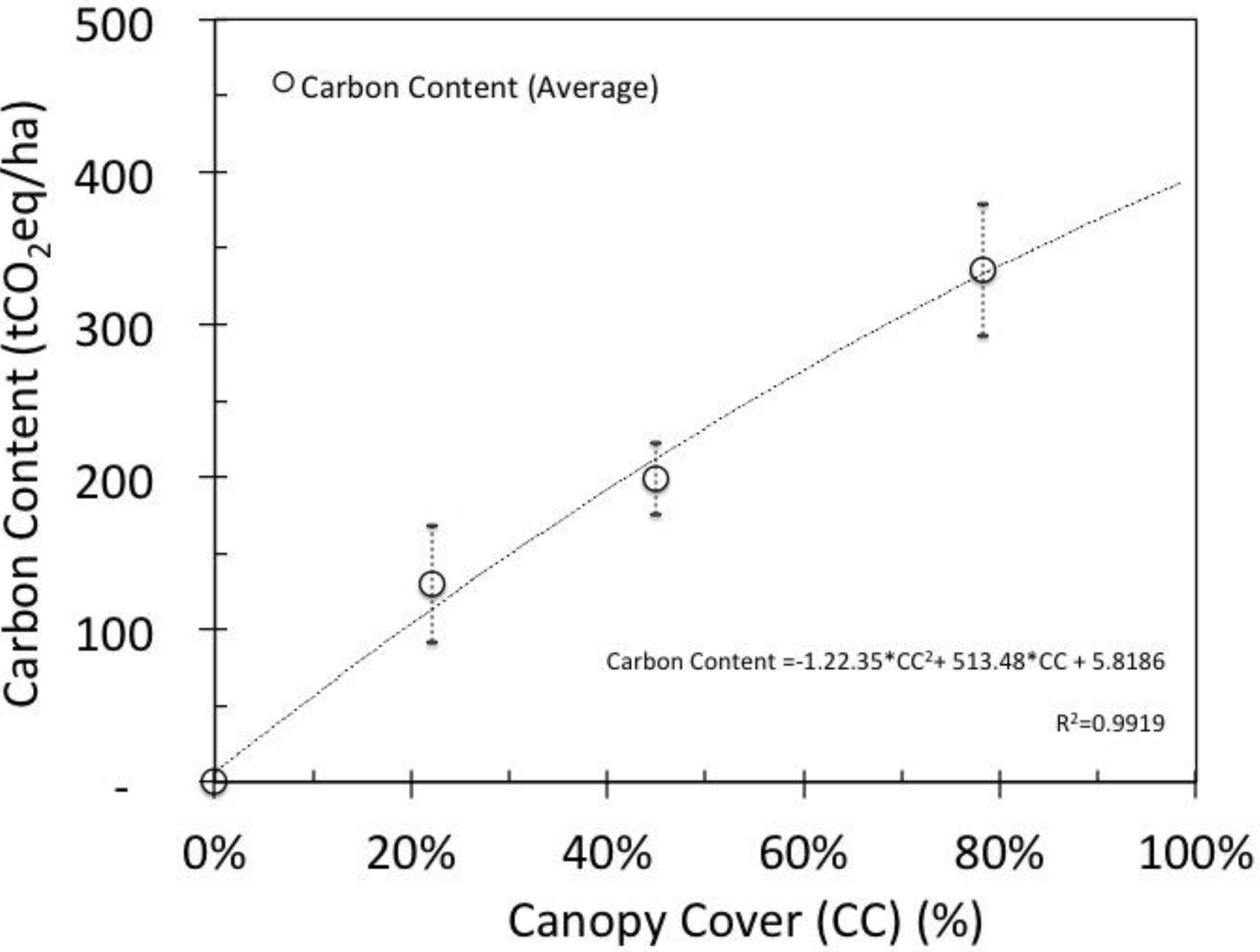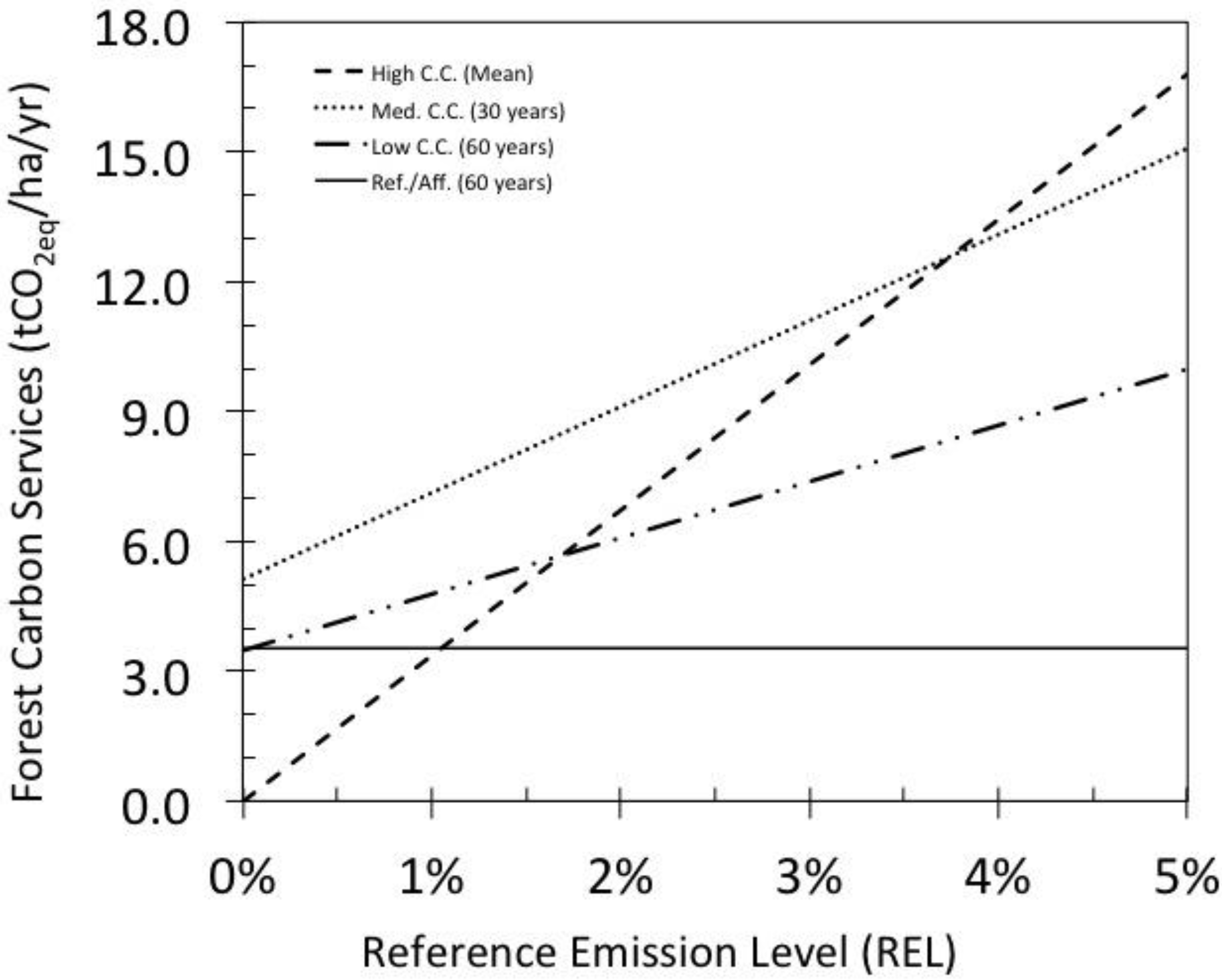Potential for Climate Change Mitigation in Degraded Forests: A Study from La Primavera, México
Abstract
:1. Introduction
2. Background
2.1. Quantification of Forest Carbon Services
2.2. Study Area

3. Methods
3.1. Forest Inventory
3.2. Allometric Equations and Growth Models
3.3. Forest Area
3.4. Tiers 1 and 2 Values for Carbon Stocks and Increments in Oak-Pine Forests

| Source | Climatic Domain and Vegetation Type | Annual Growth (ton/ha/year) * |
|---|---|---|
| IPCC, 2006 | Natural Forests in Tropical Mountain Systems | |
| North and South America (<20 year) | 2.0–6.4 | |
| North and South America (>20 year) | 0.6–1.9 | |
| Plantations in Tropical Mountain Systems | ||
| Americas Pinus | 12.7 | |
| Americas Other Broadleaf | 5.2 |
4. Results
4.1. Forest Inventory and Carbon Stocks
| Variable | Mean | S.D. | Range |
|---|---|---|---|
| Basal Area (Inventory) (m2/ha) | 17.0 | 7.5 | 1.9–37.0 |
| Weighted Mean Basal Area (m2/ha) a | 12.5 | 3.7 | 11.7–13.3 b |
| Canopy Cover (%) c | 54% | 22% | 10%–96% |
| Density (trees/ha) | 368 | 280 | 11–1144 |
| Mean Diameter at Breast Height (DBH) in Site (cm) | 27.3 | 15.8 | 14.7–158.0 |
| Mean Crown Diameter in Site (m) | 6.3 | 4.4 | 1.9–36.3 |
| Mean Height in Site (m) | 12.2 | 4.3 | 3.6–35.9 |
| % of Oaks | 62% | 30% | 0%–100% |
| Slope (%) | 12.0% | 9.3% | 1.0%–60.0% |
| Altitude (masl) | 171 | 197 | 1410–2180 |
| Strata | Mean (SD) | Range (95%) | S.E. | CI (95%) a | U b | n | |
|---|---|---|---|---|---|---|---|
| Canopy Cover (CC) (%) | Low CC <30% | 130 (63) | 59–258 | 17 | 92–168 | 29% | 13 |
| Medium CC 30%–60% | 199 (77) | 93–371 | 12 | 175–222 | 12% | 43 | |
| High CC >60% | 336 (120) | 161–624 | 21 | 293–379 | 13% | 33 | |

| Canopy Cover Class | Area (ha) | Mean (Minimum–Maximum) |
|---|---|---|
| Low CC | 10,605 | 1.38 (0.98–1.78) |
| Medium CC | 13,442 | 2.67 (2.35–2.98) |
| High CC | 324 | 0.11 (0.09–0.12) |
| Total | 24,371 | 4.16 (3.42–4.89) |
4.2. Carbon Removals
4.3. Reduced Emissions and Total Forest Carbon Services
| Change Described | Mean Biomass Growth Rate (ton/ha/year) | Basal Area (m2/ha) | ||||||
|---|---|---|---|---|---|---|---|---|
| 0 to 30 years | 30 to 60 years | 60 to 100 years | Initial | 30 years | 60 years | 100 years | ||
| Enhancement Forest Areas | ||||||||
| Low CC | 1.7 (1.0–2.4) | 2.1 (1.4–2.7) | 2.0 (1.2–2.8) | 9.4 (6.3–12.6) | 15.9 (9.5–22.2) | 21.4 (15.6–27.3) | 29.6 (23.6–35.5) | |
| Medium CC | 2.8 (2.5–3.2) | 2.3 (1.8–2.8) | 0.4 (0.2–0.7) | 14.0 (12.5–15.5) | 23.6 (21.0–26.1) | 33.5 (30.6–36.5) | 40.0 (37.7–42.3) | |
| High CC | 3.2 (2.4–3.9) | 0.2(0.0–0.4) | 0.1 (0.0–0.3) | 23.7 (21.5–25.9) | 37.0 (34.3–39.8) | 38.8 (37.1–40.6) | 39.6 (38.9–40.2) | |
| Reforestation/Afforestation | ||||||||
| Oaks (300 trees/ha) | 0.04 (0.03–0.06) | 0.12 (0.09–0.14) | 0.5 (0.4–0.6) | - | 0.4 (0.3–0.5) | 1.2 (0.9–1.6) | 4.7 (3.5–5.8) | |
| Pines (400 trees/ha) | 1.23 (0.92–1.54) | 2.47 (1.85–3.09 | 3.6 (2.7–4.5) | - | 7.2 (5.4–9.0) | 17.6 (13.2–22.0) | 34.5 (25.9–43.5) | |
| Total Reforestation/Afforestation | 1.27 (0.96–1.59) | 2.58 (1.94–3.23) | 4.1 (3.1–5.1) | - | 7.6 (5.7–9.5) | 18.8 (14.1–23.5) | 39.2 (29.4–48.9) | |
| Carbon Enhancement/Removals | 30 years | 60 years | 100 years | Scenario Restricted by Basal Area |
|---|---|---|---|---|
| Enhancement in Existing Forests | ||||
| Low CC | 0.99 (0.58–1.40) | 2.22 (1.40–2.97) | 3.77 (2.33–5.15) | 2.22 (1.40–2.97) |
| Medium CC | 2.07 (1.85–2.37) | 3.77 (3.18–4.44) | 4.16 (3.38–5.13) | 2.07 (1.85–2.37) |
| High CC | 0.06 (0.04–0.07) | 0.06 (0.04–0.08) | 0.06 (0.04–0.08) | - |
| Sub-Total Enhancement | 3.12 (2.47–3.84) | 6.05 (4.62–7.49) | 8.00 (5.75–10.36) | 4.29 (3.25–5.34) |
| Sequestration in Non-Forest areas Afforestation/Reforestation | 0.44 (0.33–0.55) | 1.33 (0.99–1.66) | 3.21 (2.41–4.01) | 1.33 (0.99–1.66) |
| Total Potential Removals (Enhancement + Sequestration) | 3.56 (2.80–4.38) | 7.37 (5.62–9.15) | 11.21 (8.16–14.37) | 5.61 (4.24–7.00) |
| Total Potential Future Carbon Stocks (Actual + Potential Removals) | 7.72 (6.22–9.27) | 11.53 (9.04–14.04) | 15.37 (11.58–19.26) | 9.77 (7.66–11.89) |
| Forest Areas | Reforestation/Afforestation (60 years) | |||
|---|---|---|---|---|
| Low CC | Medium CC | High CC | ||
| Reduced Emissions, REL = 1.0% | 1.3 (0.9–1.7) | 2.0 (1.7–2.2) | 3.4 (2.8–3.7) | - |
| Reduced Emissions, REL = 3.7% | 4.8 (3.4–6.2) | 7.3 (6.5–8.2) | 12.6 (10.3–13.7) | - |
| Carbon Removals | 3.5 (2.2–4.7) | 5.1 (4.6–5.9) | - | 3.5 (2.6–4.4) |
| Total Forest Carbon Services, REL = 1.0% | 4.8 (3.1–6.3) | 7.1 (6.3–8.1) | 3.4 (2.8–3.7) | 3.5 (2.6–4.4) |
| Total Forest Carbon Services, REL = 3.7% | 8.3 (5.6–10.9) | 12.5 (11.1–14.1) | 12.6 (10.3–13.7) | 3.5 (2.6–4.4) |

5. Conclusions
5.1. Comparison with Default Values and Local Studies
5.2. Forest Carbon Services and Incentive Based Mechanisms
5.3. Further Work
5.4. Final Conclusions
Acknowledgments
Conflicts of Interest
References
- IPCC, Intergovernmental Panel on Climate Change, 2006 IPCC Guidelines for National Greenhouse Gas Inventories. Prepared by the National Greenhouse Gas Inventories Programme; Eggleston, H.S.; Buendia, L.; Miwa, K.; Ngara, T.; Tanabe, K. (Eds.) IGES: Hayama, Japan, 2006.
- Van der Werf, G.R.; Morton, D.C.; Defries, R.S.; Olivier, J.G.J.; Kasibhatla, P.S.; Jackson, R.B.; Collatz, G.J.; Randerson, J.T. CO2 emissions from forest loss. Nat. Geosci. 2009, 2, 737–738. [Google Scholar] [CrossRef]
- Canadell, J.G.; Raupach, M.R. Managing forests for climate change mitigation. Science 2008, 320, 1456–1457. [Google Scholar]
- Beerling, D.J.; Woodward, F.I. Vegetation and Terrestrial Carbon Cycle: Modeling the First 400 Million Years; Cambridge University Press: Cambridge, UK, 2004. [Google Scholar]
- Strassburg, B.; Turner, K.; Fisher, B.; Schaeffer, R.; Lovett, A. Reducing emissions from deforestation-The “combined incentives” mechanism and empirical simulations. Glob. Environ. Chang. 2009, 19, 265–278. [Google Scholar] [CrossRef]
- United Nations Framework Convention on Climate Change. Guidance on Systems for Providing Information on How Safeguards are Addressed and Respected and Modalities Relating to Forest Reference Emission Levels and Forest Reference Levels as Referred to in Decision 1/CP.16. In Proceedings of the 2011 Durban Climate Change Conference, Durban, KZN, South Africa, 28 November 2011–11 December 2011; UNFCCC: Durban, KZN, South Africa, 2012.
- Maniatis, D.; Mollicone, D. Options for sampling and stratification for national forest inventories to implement REDD+ under the UNFCCC. Carbon Balance Manag. 2010, 5, 9. [Google Scholar] [CrossRef]
- IPCC, Intergovernmental Panel on Climate Change, Good Practice Guidance for Land Use, Land-Use Change and Forestry, Prepared by the National Greenhouse Gas Inventories Programme; Penman, J.; Gytarsky, M.; Hiraishi, T.; Krug, T.; Kruger, D.; Pipatti, R.; Buendia, L.; Miwa, K.; Ngara, T.; Tanabe, K. (Eds.) IGES: Hayama, Japan, 2003.
- United Nations Framework Convention on Climate Change, Report of the Conference of the Parties on Its Fifteenth Session, Held in Copenhagen Held From 7 to 19 December 2009; FCCC/CP/2009/11/Add.1.; UNFCCC: Durban, KZN, South Africa, 2010.
- United Nations Framework Convention on Climate Change, Report of the Conference of the Parties on Its Seventh Session, Held at Marrakesh from 29 October to 10 November 2001; FCCC/CP/2001/13/Add.1.; UNFCCC: Durban, KZN, South Africa, 2002.
- United Nations Framework Convention on Climate Change. Minimum Values for Forests (A/R Projects). Designated National Authorities, México. Available online: http://cdm.unfccc.int/DNA/ARDNA.html?CID=140 (accessed on 20 May 2012).
- CONAFOR; National Forestry Commission. Visión de México sobre REDD+. Comisión Nacional Forestal: Zapopan, México, 2010. [Google Scholar]
- Herold, M.; Román-Cuesta, R.M.; Mollicone, D.; Hirata, Y.; van Laake, P.; Asner, G.P.; Souza, C.; Skutsch, M.; Avitabile, V.; Macdicken, K. Options for monitoring and estimating historical carbon emissions from forest degradation in the context of REDD+. Carbon Balance Manag. 2011, 6, 13. [Google Scholar] [CrossRef]
- United Nations Framework Convention On Climate Change, Views on Methodological Guidance for Activities Relating to Reducing Emissions from Deforestation and Forest Degradation and the Role of Conservation, Sustainable Management of Forests and Enhancement of Forest Carbon Stocks in Developing Countries; FCCC/SBSTA/2011/MISC.7.; UNFCCC Subsidiary Body for Scientific and Technological Advice: Durban, KZN, South Africa, 2011.
- United Nations Framework Convention On Climate Change, Methodological Guidance for Activities Relating to Reducing Emissions from Deforestation and Forest Degradation and the Role of Conservation, Sustainable Management of Forests and Enhancement of Forest Carbon Stocks in Developing Countries; FCCC/SBSTA/2010/MISC.1.; UNFCCC Subsidiary Body for Scientific and Technological Advice: Durban, KZN, South Africa, 2010.
- United Nations Framework Convention On Climate Change, Report on the Expert Meeting on Forest Reference Emission Levels and Forest Reference Levels for Implementation of REDD-Plus Activities; FCCC/SBSTA/2011/INF.18.; UNFCCC Subsidiary Body for Scientific and Technological Advice: Durban, KZN, South Africa, 2011.
- Skutsch, M.; Torres, A.B.; Mwampamba, T.H.; Ghilardi, A.; Herold, M. Dealing with locally-driven degradation: A quick start option under REDD+. Carbon Balance Manag. 2011, 6. [Google Scholar] [CrossRef]
- CONANP, Natural Protected Area Management Plan for La Primavera; Comisión Nacional de Áreas Naturales Protegidas, SEMARNAT: México D.F., México, 2000.
- UNESCO, 2011. Man and the Biosphere Programme. United Nations Educational, Scientific and Cultural Organization. Available online: http://www.unesco.org/mabdb/br/brdir/directory/contact.asp?code=MEX (accessed on 29 September 2011).
- Martinez, A. Revelan satélites daño en bosque. Grafico Animado. Mural 13 de Mayo; Newspaper Article: Guadalajara, México, 2012. [Google Scholar]
- NASA 2012. Fire Chars Forest Near Guadalajara. News. Available online: http://earthobservatory.nasa.gov/IOTD/view.php?id=78058&src=eoa-iotd (accessed on 28 May 2012).
- IPCC, Intergovernmental Panel on Climate Change, Revised 1996 IPCC Guide- Lines for National Greenhouse Gas Inventories. Intergovernmental Panel on Climate Change; United Nations Environment Programme, Organization for Economic Co-Operation and Development, International Energy Agency: Paris, France, 1997.
- Alcocer, M. Programa Estatal de Accion Ante el Cambio Climatico del Estado de Jalisco. Inventario de Emisiones y Remociones de GEI en el sector de Agricultural, Bosques y Otros Usos de Suelo. Programa Estatal de Acción ante el Cambio Climático del Estado de Jalisco; Universidad Autónoma de Guadalajara: City, México, 2011–2013. [Google Scholar]
- INEGI, National Institute for Statistics and Geography, Conjunto nacional de uso de suelo y vegetación a escala 1:250000, Serie III; DGG-INEGI: México, 2005.
- INEGI, National Institute for Statistics and Geography, Conjunto nacional de uso de suelo y vegetación a escala 1:250,000 Serie IV; Instituto Nacional de Estadistica y Geografia: Aguascalientes, México, 2010.
- De Jong, B.; Anaya, C.; Masera, O.; Olguín, M.; Paz, F.; Etchevers, J.; Martínez, R.D.; Guerrero, G.; Balbontín, C. Greenhouse gas emissions between 1993 and 2002 from land-use change and forestry in México. For. Ecol. Manag. 2010, 260, 1689–1701. [Google Scholar] [CrossRef]
- Estadísticas de Incendios Forestales, CONAFOR, National Forestry Commission. Available online: http://www.conafor.gob.mx/portal/index.php/transparencia-y-rendicion-de-cuentas/transparencia-focalizada/programa-incendios-forestales (accessed on 28 May 2012).
- SEMARNAT Secretary Of Environment And Natural Resources, Volumen de la produccion forestal maderable por region y municipio segun grupo de especies 2008–2009. Secretaría de Medio Ambiente y Recursos Naturales, Delegación en el Estado. Subdelegación de Gestión para la Protección Ambiental y Recursos Naturales. Available online: http://www.inegi.org.mx/est/contenidos/espanol/sistemas/aee11/estatal/jal/default.htm (accessed on 28 May 2012).
- Alvaro Garcia Chavez, Intencional el incendio en La Primavera: Funcionario—Declaration of Alvaro Garcia Chavez Secretary of Rural Development of the State of Jalisco. El Universal, 24 April 2012.
- Gill, S.J.; Biging, G.S.; Murphy, E.C. Modeling conifer tree crown radius and estimating canopy cover. For. Ecol. Manag. 2000, 126, 405–416. [Google Scholar] [CrossRef]
- Návar, J. Allometric equations for tree species and carbon stocks for forests of northwestern México. For. Ecol. Manag. 2009, 257, 427–434. [Google Scholar] [CrossRef]
- Návar-Cháidez, J.J. The temperate forests of the state of Nuevo León: Sustainable management for goods and environmental services. Madera y Bosques 2010, 16, 51–69. [Google Scholar]
- Merlín-Bermudes, E. Estudios sobre el conocimiento de algunas especies de encino en Durango, México. Ph.D. Thesis, Universidad Autónoma de Nuevo León, Linares, México, June 2005. [Google Scholar]
- Palacios-Sanchez, L.A.; Martínez-Menes, M.; Sandoval, B.F.; Solorio, C.O.; Exebio-García, A.; Oropeza-Mota, J.L.; Palacios-Sánchez, L.A. Clasificador genérico de objetos en imágenes ETM+. Agrociencia 2006, 40, 613–626. [Google Scholar]
- Paz-Pellat, F.; Marín-Sosa, M.I.; Reyes-Reyes, M.; Ibarra-Hernández, F.; Pascual-Ramírez, F. Documento de referencia para la estimacion de la cobertura aerea anual de la vegetacion y su tendencia de cambio en el estado de Chiapas; Colegio de Postgraduados: México, 2010. [Google Scholar]
- Victoria-Hernandez, A.; Niño-Alcocer, M.; Rodríguez-Ávalos, J.A.; Argumedo-Espinoza, J.A. Generacion de información de uso de suelo y vegetación proyectos y convenios escala 1:50000; Instituto Nacional de Estadistica y Geografia: México, 2011. Available online: http://www.inegi.org.mx/eventos/2011/conf_ibero/doc/ET6_46_HERN%C3%81NDEZ.pdf (accessed on 20 September 2013).
- Phillips, O.L.; Malhi, Y.; Higuchi, N.; Laurance, W.F.; Nunez, P.V.; Vasquez, R.M.; Laurance, S.G.; Ferreira, L.V.; Stern, M.; Brown, S.; et al. Changes in the carbon balance of tropical forests: Evidence from long-term plots. Science 1998, 282, 439–442. [Google Scholar] [CrossRef]
- Santiago-Pérez, A.L.; Villavicencio-García, R. Multiple Analyses of Environmental and Structural Variables to Characterization of Quercus and Pinus in the La Primavera, Jalisco, México. In Presented at The Annual Meeting of the Association for Tropical Biology and Conservation, Morelia, México, 15–19 July 2007.
- Cairns, M.A.; Brown, S.; Helmer, E.H.; Baumgardner, G.A. Root biomass allocation in the world’s upland forests. Oecologia 1997, 111, 1–11. [Google Scholar] [CrossRef]
- Balderas Torres, A.; Lovett, J.C. Using basal area to estimate above-ground carbon stocks in forests: La Primavera Biosphere’s Reserve, Mexico. Forestry 2012, 86, 267–281. [Google Scholar] [CrossRef]
- Schreuder, H.T.; Ernst, R.; Ramirez-Maldonado, H. Statistical Techniques for Sampling and Monitoring Natural Resource; Gen. Tech. Rep. RMRS-GTR-126; U.S. Department of Agriculture, Forest Service, Rocky Mountain Research Station: Fort Collins, CO, USA, 2004. [Google Scholar]
- IPCC, Intergovernmental Panel on Climate Change, Good Practice Guidance and Uncertainty Management in National Greenhouse Gas Inventories, Intergovernmental Panel on Climate Change 2000. Available online: http://www.ipcc-nggip.iges.or.jp/public/gp/english/ (accessed on 28 May 2012).
- Shaw, J.D. Models for Estimation and Simulation of Crown and Canopy Cover. Proceedings of the Fifth Annual Forest Inventory and Analysis Symposium; Department of Agriculture Forest Service: Washington, DC, USA, 2003; p. 222. Available online: http://www.treesearch.fs.fed.us/pubs/142937 (accessed on 7 November 2013).
- Brown, S. Estimating Biomass and Biomass Change of Tropical Forests: A Primer; Food and Agriculture Organization: Rome, Italy, 1997. [Google Scholar]
- Chave, J.; Condit, R.; Aguilar, S.; Hernandez, A.; Lao, S.; Perez, R. Error propagation and scaling for tropical forest biomass estimates. Philos. Trans. R. Soc.: Biol. Sci. 2004, 359, 409–420. [Google Scholar] [CrossRef]
- Van Breugel, M.; Ransijn, J.; Craven, D.; Bongers, F.; Hall, J.S. Estimating carbon stock in secondary forests: Decisions and uncertainties associated with allometric biomass models. For. Ecol. Manag. 2011, 262, 1648–1657. [Google Scholar] [CrossRef]
- Zavala-Chávez, F. Introducción a la ecología de la regeneración natural de encino; Universidad Autónoma Chapingo: México, 2001. [Google Scholar]
- Wunder, S. Can Payments for Environmental Services Reduce Deforestation and Forest Degradation? In Realising REDD+: National Strategy and Policy Options; Angelsen, A., Brockhaus, M., Kanninen, M., Sills, E., Sunderlin, W.D., Wertz-Kanounnikoff, S., Eds.; Center for International Forestry Research: Bogor, Indonesia, 2009; pp. 213–224. [Google Scholar]
© 2013 by the authors; licensee MDPI, Basel, Switzerland. This article is an open access article distributed under the terms and conditions of the Creative Commons Attribution license (http://creativecommons.org/licenses/by/3.0/).
Share and Cite
Balderas Torres, A.; Ontiveros Enríquez, R.; Skutsch, M.; Lovett, J.C. Potential for Climate Change Mitigation in Degraded Forests: A Study from La Primavera, México. Forests 2013, 4, 1032-1054. https://doi.org/10.3390/f4041032
Balderas Torres A, Ontiveros Enríquez R, Skutsch M, Lovett JC. Potential for Climate Change Mitigation in Degraded Forests: A Study from La Primavera, México. Forests. 2013; 4(4):1032-1054. https://doi.org/10.3390/f4041032
Chicago/Turabian StyleBalderas Torres, Arturo, Ricardo Ontiveros Enríquez, Margaret Skutsch, and Jon C. Lovett. 2013. "Potential for Climate Change Mitigation in Degraded Forests: A Study from La Primavera, México" Forests 4, no. 4: 1032-1054. https://doi.org/10.3390/f4041032
APA StyleBalderas Torres, A., Ontiveros Enríquez, R., Skutsch, M., & Lovett, J. C. (2013). Potential for Climate Change Mitigation in Degraded Forests: A Study from La Primavera, México. Forests, 4(4), 1032-1054. https://doi.org/10.3390/f4041032





